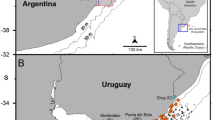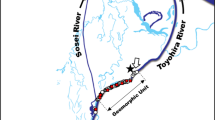Abstract
The objectives of this study were to determine (1) the seasonal timing and diel activity patterns of lacustrine brook charr when migrating to a lake outlet for spawning, and (2) the homing of reproducing individuals. In 1995, 745 individuals were captured while migrating to the spawning ground compared to 1148 in 1996. In both years, the sex ratio was not significantly different from 1 : 1 but females were significantly longer than males. The spawning migrations lasted about 48 d and were more nocturnal (between 20:00 and 8:00 h) than diurnal. The migration to the spawning ground began when water temperature decreased to 13°C and peaked when water temperature decreased from 11°C to 7°C. Peaks in migration activity were always preceded by a sudden decrease followed by an increase in temperature. The spawning migration lasted until the third week of October, when water temperature varied between 3°C and 8°C. Males, especially larger ones, arrived on the spawning ground before females in both years. The length of males migrating to the spawning ground decreased during the spawning season while the females' length showed no pattern. Only 9.7% of the 745 fin-clipped individuals from 1995 returned to the lake outlet to spawn in 1996. The results of this study indicate that lacustrine brook charr show similarities to other anadromous and lake-spawning salmonid populations when migrating to spawning grounds.
Similar content being viewed by others
References cited
Bernier-Bourgault, I. & P. Magnan. 2002. Factors affecting smallscale redd site selection and hatching and emergence success of brook charr, Salvelinus fontinalis, in streams. Env. Biol. Fish. (this volume).
Blanchfield, P.J. & M.S. Ridgway. 1997. Reproductive timing and use of redd sites by lake-spawning brook trout (Salvelinus fontinalis). Can. J. Fish. Aquat. Sci. 54: 747–756.
Bourke, P., P. Magnan & M.A. Rodriguez. 1997. Individual variations in habitat use and morphology in brook charr. J. Fish Biol. 51: 783–794.
Castonguay, M., G.J. FitzGerald & Y. Côté. 1982. Life history and movements of anadromous brook charr, Salvelinus fontinalis, in the St-Jean River, Gaspé, Québec. Can. J. Zool. 60: 3084–3091.
Chapman, D.W. 1988. Critical review of variables used to define effects of fines in redds of large salmonids. Trans. Amer. Fish. Soc. 117: 1–21.
Curry, R.A., J. Gehrels, D.L.G. Noakes & R. Swainson. 1994. Effects of river flow fluctuations on groundwater discharge through brook trout, Salvelinus fontinalis, spawning and incubation habitats. Hydrobiologia 277: 121–134.
Curry, R.A. & D.L.G. Noakes. 1995. Groundwater and the selection of spawning sites by brook trout (Salvelinus fontinalis). Can. J. Fish. Aquat. Sci. 52: 1733–1740.
Curry, R.A., D.L.G. Noakes & G.E. Morgan. 1995. Groundwater and the incubation and emergence of brook trout (Salvelinus fontinalis). Can. J. Fish. Aquat. Sci. 52: 1741–1749.
Curry, R.A. & K.J. Devito. 1996. Hydrogeology of brook trout (Salvelinus fontinalis) spawning and incubation habitats: implication for forestry and land use development. Can. J. For. Res. 26: 767–772.
Dutil, J.D. & G. Power. 1980. Coastal population of brook trout, Salvelinus fontinalis, in Lac Guillaume-Delisle (Richemond Gulf) Québec. Can. J. Zool. 58: 1828–1835.
Elson, P.F. 1938. The effect of control of temperature and current on the migration of brook trout. Fish. Res. Board Can. Rep. Biol. St. 132: 1–32.
Fraser, J.M. 1982. An atypical brook charr (Salvelinus fontinalis) spawning area. Env. Biol. Fish. 7: 385–388.
Fraser, J.M. 1985. Shoal spawning of brook trout, Salvelinus fontinalis, in a precambrian shield lake. Nat. Can. 112: 163–174.
Hawkins, A.D. & G.W. Smith. 1986. Radio-tracking observations on Atlantic salmon ascending the Aberdeenshire Dee. Scottish Fish. Res. Rep. 36: 1–24.
Hazzard, A.S. 1932. Some phases of the life history of the eastern brook trout, Salvelinus fontinalis (Mitchill). Trans. Amer. Fish. Soc. 62: 344–350.
Hokanson, K.E.F., J.H. McCormick, B.R. Jones & J.H. Tucker. 1973. Thermal requirements for maturation, spawning and embryo survival of brook trout, Salvelinus fontinalis. J. Fish. Res. Board Can. 30: 975–984.
Magnan, P. & G.J. FitzGerald. 1983. Âge scalaire et otolithique de l'omble de fontaine (Salvelinus fontinalis): comparaison et interprétation des faux annuli. Nat. Can. 110: 149–154.
O'Connor, J.F. & G. Power. 1973. Homing of brook trout (Salvelinus fontinalis) in Matamek Lake, Québec. J. Fish. Res. Board Can. 30: 1012–1014.
Power, G. 1980. The brook charr, Salvelinus fontinalis. pp. 141–203. In: E.K. Balon (ed.) Charrs: Salmonid Fishes of the Genus Salvelinus, Dr W. Junk Publishers, The Hague.
Scott, W.B. & E.J. Crossman. 1974. Poissons d'eau douce du Canada. Office des recherches sur les pêcheries du Canada, Ministère de l'environnement, Service des pêches et des sciences de la mer, Bulletin 184, Ottawa. 1026 pp.
Smith, M.W. & J.W. Saunders. 1958. Movements of brook trout, Salvelinus fontinalis (Mitchill), between and within fresh and saltwater. J. Fish. Res. Board Can. 15: 1403–1449.
Snucins, E.J., R.A. Curry & J.M. Gunn. 1992. Brook trout (Salvelinus fontinalis) embryo habitat and timing of alevin emergence in a lake and stream. Can. J. Zool. 70: 423–427.
Trépanier, S., M.A. Rodriguez & P. Magnan. 1996. Spawning migrations in landlocked Atlantic salmon: time series modelling of river discharge and water temperature effects. J. Fish Biol. 48: 925–936.
Vladykov, V.D. 1942. Precision with which speckled trout (Salvelinus fontinalis) return to the same spawning grounds. Canadian Field Naturalist 56: 143–136.
Webster, D.A. & G. Eiriksdottir. 1976. Upwellingwater as a factor influencing choice of spawning sites by brook trout (Salvelinus fontinalis). Trans. Amer. Fish. Soc. 105: 416–421.
White, H.C. 1940. Life history of sea-running brook trout (Salvelinus fontinalis) of Moser River, N.S. J. Fish. Res. Board Can. 5: 176–186.
Witzel, L.D. & H.R. MacCrimmon. 1983a. Redd-site selection by brook trout and brown trout in southwestern Ontario streams. Trans. Amer. Fish. Soc. 112: 760–771.
Witzel, L.D. & H.R. MacCrimmon. 1983b. Embryo survival and alevin emergence of brook charr, Salvelinus fontinalis, and brown trout, Salmo trutta, relative to redd gravel composition. Can. J. Zool. 61: 1783–1792.
Young, M.K., W.A. Hubert & T.A. Wesche. 1989. Substrate alteration by spawning brook trout in a southeastern Wyoming stream. Trans. Amer. Fish. Soc. 118: 379–385.
Author information
Authors and Affiliations
Corresponding author
Rights and permissions
About this article
Cite this article
Baril, M., Magnan, P. Seasonal Timing and Diel Activity of Lacustrine Brook Charr, Salvelinus Fontinalis, Spawning in a Lake Outlet. Environmental Biology of Fishes 64, 175–181 (2002). https://doi.org/10.1023/A:1016097704008
Issue Date:
DOI: https://doi.org/10.1023/A:1016097704008




